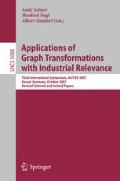Abstract
In this contribution, we introduce an extension of the graph transformation language PROGRES that allows to specify repetitive subgraphs in a compact and comprehensible way. They can be pattern-matched as well as created. Unlike other approaches, the extension supports specifying successively connected repetitive subgraphs, i.e. inter-connections among the repeated instances of the subgraphs are expressed by edges in the graph pattern. The need for this modeling feature arose during a case study with the software company innotec developing tools for data handling in chemical engineering development processes. In this paper, we introduce syntax and semantics of the extension by giving a translation of extended PROGRES transformations into plain PROGRES. Furthermore, we show the application of this modeling feature within our project dealing with consistency maintenance.
Access this chapter
Tax calculation will be finalised at checkout
Purchases are for personal use only
Preview
Unable to display preview. Download preview PDF.
References
Schürr, A.: PROGRES: A Visual Language and Environment for PROgramming with Graph REwrite Systems. In: Aachener Informatik Bericht 94-11, RWTH Aachen University, Germany, Fachgruppe Informatik (1994)
Agrawal, A., Karsai, G., Shi, F.: Graph Transformations on Domain-Specific Models. Technical report, Vanderbilt University, Institution for Software Integrated Systems, Nashville, Tennessee (2003) ISIS-03-403
Taentzer, G.: AGG: A Tool Environment for Algebraic Graph Transformation. In: Nagl, M., Schürr, A., Münch, M. (eds.) AGTIVE 1999. LNCS, vol. 1779, pp. 481–488. Springer, Heidelberg (2000)
Becker, S.M., Haase, T., Westfechtel, B., Wilhelms, J.: Integration tools supporting cooperative development processes in chemical engineering. In: Proc. of the 6th World Conf. on Integrated Design & Process Technology (IDPT 2002), SDPS, p. 10 (2002)
Körtgen, A., Becker, S.M., Herold, S.: A Graph-Based Framework for Rapid Construction of Document Integration Tools. In: Proc. of the 11th World Conf. on Integrated Design & Process Technology (IDPT 2007), SDPS, p. 13 (2007)
Schürr, A.: Specification of Graph Translators with Triple Graph Grammars. In: Proc. of the 20th Intl. Workshop on Graph-Theoretic Concepts in Computer Science (WG 1994), Herrsching, Germany. LNCS, vol. 903, pp. 151–163. Springer, Heidelberg (1995)
Becker, S.M., Westfechtel, B.: UML-based Definition of Integration Models for Incremental Development Processes in Chemical Engineering. In: Proc. of the 7th Intl. Conf. on Integrated Design and Process Technology (IDPT 2003), SDPS, p. 10 (2003)
Schürr, A., Winter, A.J., Zündorf, A.: Visual Programming with Graph Rewriting Systems. In: Proc. of the 11th Intl. IEEE Symposium on Visual Languages (VL 1995), Washington, DC, USA. IEEE Computer Society Press, Los Alamitos (1995)
Fischer, T., Niere, J., Torunski, L., Zündorf, A.: Story Diagrams: A new Graph Rewrite Language based on the Unified Modeling Language. In: Ehrig, H., Engels, G., Kreowski, H.-J., Rozenberg, G. (eds.) TAGT 1998. LNCS, vol. 1764, pp. 296–309. Springer, Heidelberg (2000)
Fuss, C., Tuttlies, V.E.: Simulating Set-Valued Transformations with Algorithmic Graph Transformation Languages. In: AGTIVE 2007. LNCS, p. 16. Springer, Heidelberg (2008)
Tuttlies, V.E.: Further Language Constructs for Rule-based Model Transformation. Diploma Thesis, Department of Computer Science 3, RWTH Aachen University (2006)
Speulmanns, A.: Visuelles Programmieren mit Graphersetzungsregeln. Diploma Thesis, Department of Computer Science 3, RWTH Aachen University (1995)
Taentzer, G., Beyer, M.: Amalgamated Graph Transformations and Their Use for Specifying AGG - an Algebraic Graph Grammar System. In: Proc. of the Intl. Workshop on Graph Transformations in Computer Science, London, UK, pp. 380–394. Springer, Heidelberg (1994)
Milicev, D.: Automatic Model Transformations Using Extended UML Object Diagrams in Modeling Environments. IEEE Trans. Softw. Eng. 28(4), 413–431 (2002)
Drewes, F., Hoffmann, B., Janssens, D., Minas, M., Van Eetvelde, N.: Shaped Generic Graph Transformation. In: AGTIVE 2007. LNCS, p. 16. Springer, Heidelberg (2008)
Author information
Authors and Affiliations
Editor information
Editors and Affiliations
Rights and permissions
Copyright information
© 2008 Springer-Verlag Berlin Heidelberg
About this paper
Cite this paper
Körtgen, AT. (2008). Modeling Successively Connected Repetitive Subgraphs. In: Schürr, A., Nagl, M., Zündorf, A. (eds) Applications of Graph Transformations with Industrial Relevance. AGTIVE 2007. Lecture Notes in Computer Science, vol 5088. Springer, Berlin, Heidelberg. https://doi.org/10.1007/978-3-540-89020-1_29
Download citation
DOI: https://doi.org/10.1007/978-3-540-89020-1_29
Publisher Name: Springer, Berlin, Heidelberg
Print ISBN: 978-3-540-89019-5
Online ISBN: 978-3-540-89020-1
eBook Packages: Computer ScienceComputer Science (R0)

